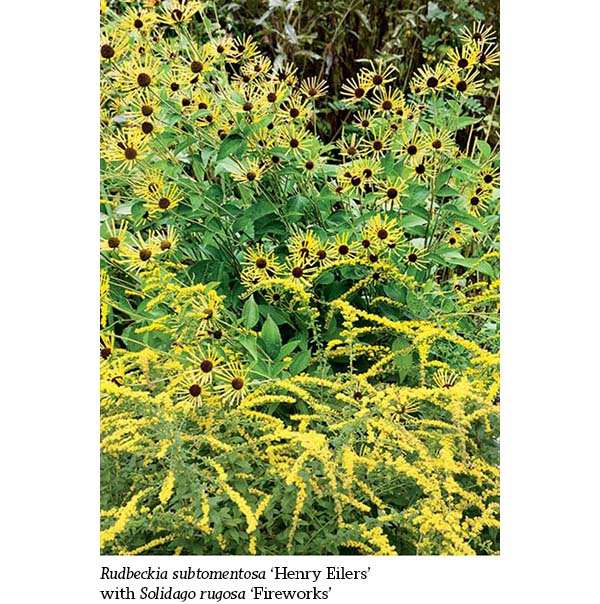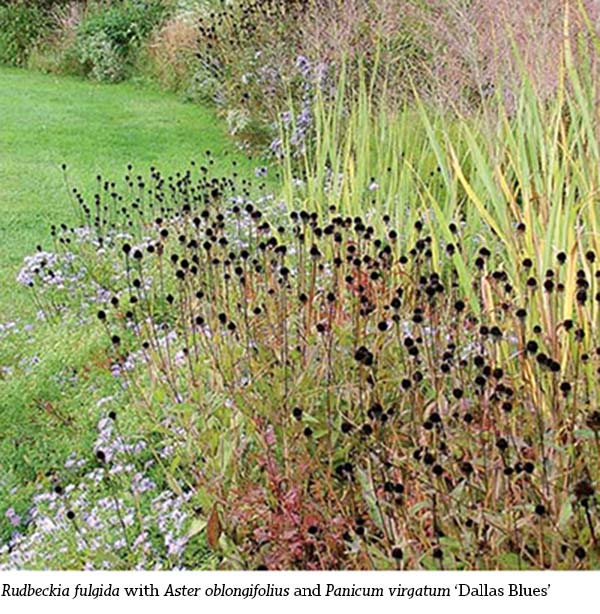
Rudbeckia
go for the gold
Rudbeckias
Full sun to light shade; average, well-drained soil
The bright blooms of rudbeckias (Rudbeckia) are a welcome sight in warm-season beds and borders. There are a number of species to choose from, in a relatively limited range of colors but a variety of heights. Orange coneflower (R. fulgida)—which is not actually orange but on the warm side of yellow that’s commonly called “gold” in flowers—produces dark-centered, daisy-form flowers atop 2- to 4-foot-tall stems. Sweet coneflower (R. subtomentosa) looks similar but grows to about 5 feet. Three-lobed coneflower (R. triloba), also known as brown-eyed Susan, has similar-looking but smaller blooms on 2- to 5-foot-tall plants.
Giant coneflower (R. maxima), also known as swamp coneflower, is yet another species with dark-centered, golden flowers, but it’s distinctive for its blue leaves, which appear mostly near the base of the 5- to 7-foot-tall stems. Two species that can get even taller (to 8 feet) include shining or shiny coneflower (R. nitida), with green-centered, golden flowers, and cutleaf or ragged coneflower (R. laciniata), with single or double, green-centered, clear yellow blooms.
All of these species flower from mid- or late summer to early fall and are hardy in Zones 3 to 9, except for giant coneflower, which is recommended for Zones 5 to 9.
Color Considerations
There’s nothing subtle about the blooms of rudbeckias. For a traffic-stopping summer show, pair their sunny daisies with other yellow flowers and yellow-variegated grasses. (Use the grasses or other leafy companions to separate warm golden yellows from cooler greenish yellows, which can look a bit awkward right next to each other in borders that you see up close.)
Rudbeckias are also wonderful in exuberant combinations with other vibrant colors, including rich reds, like those of cardinal flower (Lobelia cardinalis), and bright to rusty oranges, like those of heleniums (Helenium) and torch lilies (Kniphofia). They look terrific with blues and purples, from saturated shades, like those of ‘Blue Paradise’ summer phlox (Phlox paniculata) and ‘Purple Dome’ New England aster (Aster novae-angliae), to lighter purple-blues and silvery blues, like those of ‘Blue Fortune’ anise hyssop (Agastache) and globe thistles (Echinops).
A Perfect Match
Dark-leaved shrubs, such as ‘Royal Purple’ smokebush (Cotinus coggygria), and superdark ornamental grasses, such as Vertigo fountain grass (Pennisetum purpureum ‘Tift 8’), are among my top picks for rudbeckia partners. The bright petals show off beautifully against a deep purple backdrop, and the dark leaves make an excellent echo for the purple-brown to near-black centers of these summer daisies.
Shapes and Textures
Most rudbeckias have an upright habit, though ‘Goldsturm’ and other selections of R. fulgida create broad mounds when you plant them in groups of three or more. Giant coneflower’s tall, almost leafless flower stems give it a strongly vertical habit, and its broad basal leaves offer bold foliage interest. Other rudbeckias aren’t especially distinctive for either their habit or their leaves. Their daisy-shaped flowers make them standouts in bloom, though. Repeat their shape with other daisy-form flowers, like those of asters, coreopsis (Coreopsis), and echinaceas (Echinacea); match them with equally bold blossoms, like those of hardy hibiscus (Hibiscus) and lilies (Lilium); or go high contrast with strikingly spiky partners, such as blazing stars (Liatris) and perennial salvias (Salvia).
Seasonal Features
Rudbeckias perk up the summer garden just as many earlier perennials finish their show or take a break, providing welcome color through the warmest part of summer along with other mid- to late summer sun lovers, such as balloon flower (Platycodon grandiflorus), daylilies (Hemerocallis), and Russian sages (Perovskia).
Most rudbeckias continue to open new flowers into early fall, so they pair well with partners that bridge the two seasons, such as Joe-Pye weeds (Eupatorium) and goldenrods (Solidago). After their colorful petals drop, their center cones stick around into winter, adding interest among the dried skeletons and seed heads of other long-lasting perennials, such as ‘Autumn Fire’ sedum (Sedum), Culver’s roots (Veronicastrum), and many ornamental grasses.
Special Effects
Native to meadow and prairie habitats, rudbeckias are obvious choices for naturalistic beds and borders. They look right at home with the slender leaves and airy plumes of ornamental grasses: Try little bluestem (Schizachyrium scoparium) and prairie dropseed (Sporobolus heterolepis) with the shorter rudbeckia cultivars, for instance, and Indian grass (Sorghastrum nutans) or switch grasses (Panicum) with cutleaf, giant, and shining coneflowers. Add some other perennials with flowers that offer an abundance of nectar and/or seeds, such as bee balms (Monarda), heleniums (Helenium), and purple coneflower (E. purpurea), and your beautiful backyard meadow will do double-duty as a haven for birds, butterflies, and beneficial insects.
Bloom Buddies
Marvelous Matches for Flowering Combos
Ideal growing sites for most rudbeckias (Rudbeckia) offer full sun and average to moist—but not waterlogged—soil. The plants can tolerate light shade, too, and may adapt to dry conditions once they’re established. Their long bloom period means that there are lots of potential partners to choose from; below are some of the many complementary companions.
Asters (Aster)
Balloon flower (Platycodon grandiflorus)
Blackberry lily (Belamcanda chinensis)
Blazing stars (Liatris)
Blue mist shrub (Caryopteris × clandonensis)
Daylilies (Hemerocallis)
Echinaceas (Echinacea)
Globe thistles (Echinops)
Goldenrods (Solidago)
Joe-Pye weeds (Eupatorium)
Mountain fleeceflower (Persicaria amplexicaulis)
Rattlesnake master (Eryngium yuccifolium)
Russian sages (Perovskia)
Sedums (Sedum)
Summer phlox (Phlox paniculata)
Torch lilies (Kniphofia)
Yarrows (Achillea)
Exploring More Options: Partners beyond Perennials
Black-eyed Susan (Rudbeckia hirta) can act like a perennial in some areas, but it more often lasts only one or two growing seasons. Its flowers are so pretty, though, that it’s worth including it in combinations even if it acts like an annual for you. Also known as Gloriosa daisies, the plants offer a wide range of warm colors, including two-toned yellow ‘Prairie Sun’ and golden yellow ‘Irish Eyes’ (both with green centers); light-and-dark red ‘Cherry Brandy’; maroon-and-orange ‘Chocolate Orange’; and mixes that include yellows, golds, oranges, and rusts, such as ‘Cherokee Sunset’ and ‘Chim Chiminee’. You can find single, semidouble, and double-flowered forms, and cultivars can range from 6 inches to 3 feet in height. They flower for such a long time—from late spring or early summer well into fall—that if they don’t make it through winter, they still earn their keep!





